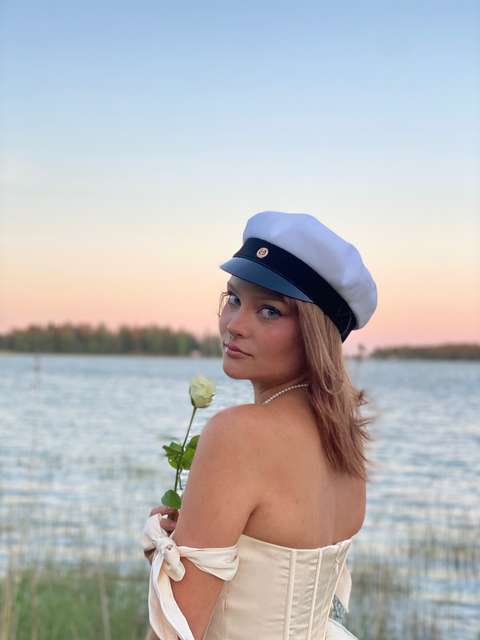Alumnus story: From visual arts programme to university to study history
Selja Rögård graduated from the visual arts programme of her upper secondary school in 2024. In the autumn of the same year, she started her studies at Tampere University. Her favourite subject at secondary school and upper secondary school became her main subject at university.
Selja Rögård graduated in 2024 from the Matinkylän lukio upper secondary school. The new upper secondary school building was completed just before she left, so she only studied a couple of weeks, completed her matriculation exams and celebrated her graduation there.
Selja attended the visual arts programme of her upper secondary school. Already in secondary school her studies emphasised visual arts. At the time, the Matinkylän lukio upper secondary school was called the Kaitaan lukio upper secondary school and it was her local upper secondary school. She had the impression that she would find like-minded people in the visual arts programme. And when in upper secondary school she had the opportunity to complete a visual arts diploma (a way of completing a matriculation exam in visual arts, in a sense), the choice felt right. “The entrance exams were held during the pandemic, so they were held remotely, which meant that I wasn’t really nervous. I’d have been more nervous in the school premises. Still, the time limit of the exams caused some nervousness,” says Selja.
Diverse visual arts
At the Matinkylän lukio upper secondary school, students could study visual arts very diversely: the options included painting, pencil drawing, ceramics, photography and contemporary art. For her diploma, Selja made a series of five clay masks. The topic was the decoration of the body in different cultures.
In Selja’s opinion, the digital visual arts course was the most beneficial for her future after upper secondary school. On the course, student learned to create and edit images digitally. “I recently needed this skill,” says Selja.
She enjoyed her time at the Matinkylän lukio upper secondary school. In her opinion, the staff and teachers are very professionally competent. “I had the best fellow students. Even though I wasn’t friends with everyone, the school had a good team spirit and atmosphere,” Selja says.
Selja’s best memory of upper secondary school is the second-year students’ dance and their after party. Thanks to the dance, she got to meet new people.
Lessons for life
In upper secondary school, students learn a lot of things that will benefit them later in life, such as good writing skills. However, the life lesson remains clear in Selja’s mind is this: “Network and get to know people. At the beginning of upper secondary school, I though that since I already had two friends, I wouldn’t need any others. Now at university, I’ve tried to talk to everyone and really network.”
In Selja’s opinion, networking is important, because having friends and people you know makes the daily school life much more comfortable. You do not need to spend break times alone or sit by yourself at the cafeteria. Networking also makes it easier to find a partner for the second-year students’ dance, for example. “On the other hand, you shouldn’t choose courses based on what your friends choose; you should only choose what really interests you,” Selja says.
Selja’s favourite subjects in upper secondary school were history and religion. History had already been a favourite back in secondary school. Physics and mathematics, on the other hand, were not in favour. “We had a lot of compulsory mathematics courses, but I’m more of a humanities type.
After her graduation in spring, Selja was accepted, based on her school certificate, to study history at Tampere University. “After the Helsinki Metropolitan Area, Tampere is my favourite city, and I’m already familiar with the region. Manserock music (e.g. Eppu Normaali and Juice Leskinen), is also close to my heart.”
Selja’s studies at the university have started smoothly. It has been somewhat surprising that there are no lectures every day, only three days a week. “A lot of the studies are completed independently, which is something I encourage others to prepare for. If there are no lectures, we study from books, write lecture diaries or do our coursework,” Selja explains.
Art is still part of life
Selja’s plans for the future are still taking shape, but becoming a teacher is one option. In the work of a teacher, the holidays are a big plus. “And my mother is a language teacher, which means that I’ve seen the work and what it entails,” Selja says.
Selja has not abandoned art completely, although she engages in it less than before. She admits to drawing during lectures when she is bored. At the moment, she is making pearl curtains for her bed recess. In Tampere, she has visited a deserted house that is open to the neighbourhood and where people can go to make art.
Ninth graders: listen to this advice
For current ninth graders Selja has a few tips for choosing their upper secondary school: “Of course you should think about how you will get to school every day, but if you really want to go to a certain upper secondary school, the distance doesn’t matter,” Selja says. “You don’t need to go where your friends are going, you’ll make new friends at your new school,” she continues.
Selja also recommends networking and getting to know everyone, forgetting any biases you might have. She also recommends taking notes on paper during lessons, if the computer in front of you becomes distracting and you notice using your learning time on gaming.
Selja also advises not to think too much about the averages of different upper secondary schools. “Remember that even teachers have attended different upper secondary schools and have still advanced to further studies. All upper secondary school teachers have received the same high-quality Finnish university education.”
